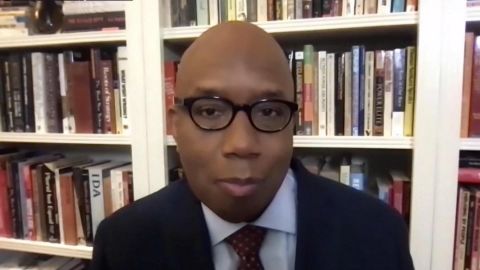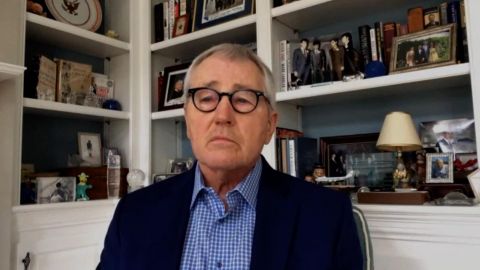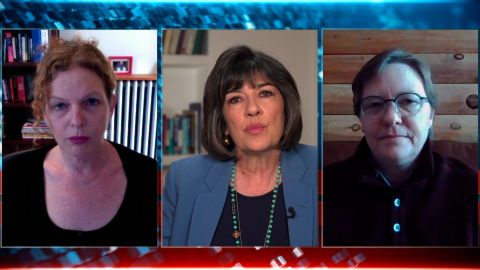Read Transcript EXPAND
CHRISTIANE AMANPOUR: And we turn to New York where the governor, Andrew Cuomo, is under fire for his lack of transparency about the scope of COVID-19 related deaths in nursing homes. More than 15,000 care home residents have died from COVID according to the New York Department of Health. The governor insists there was no cover-up, but acknowledges that information about the deaths should have been released faster. Errol Louis is a seasoned political host for “Inside City Hall” on the New York One Channel. And he is here to talk to our Michel Martin about this unfolding story.
(BEGIN VIDEOTAPE)
MICHEL MARTIN: Thanks, Christiane. Errol Louis, thank you so much for speaking with us today.
ERROL LOUIS, POLITICAL ANCHOR, SPECTRUM NEWS: Absolutely. Glad to be with you, Michel.
MARTIN: Look, it’s a complicated story. But as briefly as you can, what is happening with Governor Cuomo and can you walk us through what the center of the dispute is about?
LOUIS: Look, the center of the dispute, Michel, was a key point in the early part of the pandemic, near its peak, when the governor and the State of New York made a decision about nursing homes, about what to do. And this is in the context of what was expected to be a very serious shortage of hospital beds. There were credible sources, including Columbia University that said publicly that New York might need — the State of New York would need 140,000 hospital beds, and this is a state that has about 51,000 hospital beds. And so, everything was really mobilized around the idea that we have to make sure we’ve got more hospital beds. And in that context, Michel, there was an order that came down in late March instructing the nursing homes and hospitals that when somebody has been discharged from a hospital, that bed has to be freed up, and that patient has to go back to their nursing home, which is after all is their home. Whether or not they were COVID positive, they could not remain in the hospital indefinitely once they were discharged. That was the policy. What that then led to was conceivably, and there is some evidence of this now, that it made the situation in nursing homes a little bit worse. But that is not the real problem. The real problem came later on in the year when asked about this by a number of the news organizations, including ours, they were asked why, or what were the deaths that happened in nursing homes compared to in hospitals? Meaning, if somebody was taken from a nursing home, brought to a hospital and then died of COVID, who do you attribute to death to? Is it attributed to the hospital or to the nursing home? And the state government stopped providing that information and they refused to provide the information, and we later subsequently discovered that they deliberately did that because they thought that the federal government was probing them, they thought that it was a bad faith kind of an effort to make the state look bad by the Trump administration, which is certainly plausible and that therefore were not going to provide the information. That’s the basis of the problem.
MARTIN: So, the issue isn’t that the deaths were not reported at all, they were reported somewhere, the question is, how they were attributed or to which institution they were attributed. So, there is — the governor is not being accused of undercounting the deaths from COVID writ large, right?
LOUIS: That is correct. Although, some of his more enthusiastic political rivals are accusing him of all kinds of different things, including that. But realistically, what — the defense of the Cuomo administration had been a while now is that they’re saying look, it is not like we didn’t tell you what the deaths were, we just didn’t report it in the format. And frankly, there are a number of other states around the country that don’t break out the difference say between nursing home deaths and the hospital deaths. But the real problem is that they have acknowledged that they were specifically, and for political reasons, what sounds like political reasons, they were specifically not telling us about a distinction that they did know. And here’s where it really matters, Michel. If you’re a family and you’ve a loved one living in assisted living or in a nursing home, you have every right to know down to the decimal number exactly how much infection is going on, exactly how much risk you are taking by leaving your loved one in that setting, because you could always take them out if you had to, if you knew what the real risks were, what the real danger was, what the real infection and hospitalization and death rates were, but we didn’t have that information. And it’s those families, I think, and we think that there could be 7,000 to 10,000 of them, they are really, really upset with the governor, and that is what I think is making this scandal not go away, that’s what takes it out of politics and into the real world where real people think that maybe they have been harmed by their actions.
MARTIN: I do want to hear more about what is the harm that people feel worse (ph) experienced. I mean, one of the things that has been implicated here is Governor Cuomo’s relationship with the nursing home industry. What is the issue there?
LOUIS: Well, the issue there is that there is a very powerful nursing home lobby in New York. In fact, I don’t know what goes on in other states, but in New York, something like 3/4 of assisted living in nursing home operations are for profit. They are companies. You know, they are out here trying to make a buck. And in many cases, they have made extravagant amounts of donation. We don’t have a whole lot of campaign finance reform in New York when it comes to state governments. And so, they’re very powerful. They’ve given a ton of money to Governor Cuomo and other state politicians over the years. They wield a lot of influence and they have managed to get an immunity provision that was stuck into the state budget while all of this pandemic was going on that essentially made them, I guess lawsuit-proof, is one way to put it. It essentially immunized them against a lot of litigation that would — that might have otherwise happened. And this was seen as a smoking gun.
MARTIN: But how was it a favor to the nursing homes to insist that people who may or may not have COVID are returned to their facilities?
LOUIS: Well, I mean, again, the clear incentive was simply to make sure that this — what was thought to believe — what was believed to be a hospital bed shortage would not overwhelm and collapse the system in New York, that was the motivation, the original motivation. Once it became clear that we — I think we topped out at something like 20,000 beds being used at any one time, that those fears were simple — they just sit and didn’t materialize, the next line of, I guess, favors that you might expect the nursing home industry to see is that they didn’t want to be sued. That they were going to clearly be a lot of deaths, there was going to be a lot of sickness, there was going to be a lot of litigation, that’s what families do when something happens, that they didn’t expect and think that maybe care wasn’t what it should have been, and they got an immunity provision.
MARTIN: So, what has been the issue for the families, family members and people who are living in these nursing homes? Is the issue for them that people will return to these homes and weren’t adequately cared for? Is the issue for them that they just didn’t know what the expense of the illness might have been? I mean, is the issue for them is that people were sent back to nursing homes and they weren’t receiving adequate care or is the real issue for them that they just didn’t know?
LOUIS: The real issue is the knowledge. There were horrific stories where, you know, they were creating freezers behind some nursing homes to store the bodies, you know. In some cases, there were terrible rates of infection. And again, at the beginning of the pandemic, we weren’t entirely clear on whether it was coming from individuals, was it from surfaces. Nursing home and assisted living facilities, as you know, they have lots and lots of vendors who come in and out every day. They’re bringing in food, they’re bringing in and medicine, the staff changes on a, you know, three shifts a day and maybe two shifts, but there a lot of people in and out of those places. And so, it wasn’t clear why these rates were spiking, why people were dying so quickly, what needed to be done to take care of them. And it left families in a really, really precarious position, because they did not know what was happening. And once that information flow was choked off or the information was frankly distorted as far as how it was being reported, there are families who just went ballistic, and they had every right to do so, frankly.
MARTIN: And speaking of how this was reported, how was this reported at this time? My recollection was that New York was saying that, in fact, the fatalities in nursing homes were superior to that of other parts of the country. And I think what you’re now saying is that’s just not true.
LOUIS: Yes. That is right. I mean, look, this is one of these cases where there was kind of a split between what the national story was and what the local story was. Those televised press conference that Governor Cuomo had day after day, there was a national portion that would be covered on places like CNN and MSNBC, and then that would kind of go away. And we in the local media would continue to ask questions and they were more New York-specific. And day after day, I mean, he had 100 straight days of press conferences. I think I might have missed maybe 10 of them. We asked over and over and over again, what is going on with the nursing homes? Why aren’t we getting the data? When are you going to know? And so, when an independent investigation finally was done by the state attorney general at the governor’s request, I might add, it’s not as if they didn’t know that something was coming, it turned out that they had rather seriously undercounted the number of deaths that could reasonably be attributed to nursing homes. That it was almost half of what the total number really should have been. And it made it seem, at that point, as if the governor was trying to sort of burnish his credentials, make the state’s performance look better than it was compared to other states and it added one more layer of difficulty from those who were upset all along that the information was being withheld.
MARTIN: Is there evidence that he ordered the withholding of this information or was that decision made, you know, somewhere else?
LOUIS: Well, that is the part that — where — that brings us fully up to date, Michel. That’s what the FBI and Justice Department investigation that has now been launched is likely to try and figure out how exactly did this come down. There was at least one of the public statement or conversation between a top aide — the top aide to the governor and members of the state legislature who are understandably outraged and asking for answers, because they’ve been asking for this data all along. And they were told in a public setting, basically, that we froze the data, we didn’t want to give it to you or anybody else, because we knew that the Trump administration was coming after us for what were perceived to be nefarious reasons. That was the gist of that conversation. That is more than enough, I think, to get the attention in this case of the Justice Department. Saying, well, wait a minute now, if you are deliberately withholding information from the federal government about something as serious as fatalities in the middle of this pandemic, we’ve got to make sure that this was done right. We want to know who gave that order. We want to know why this happened. And what bad effects and possibly breaches of protocol and even the law might have happened.
MARTIN: And what has the governor, the sort of famously talkative governor, had to say about all of this?
LOUIS: He has not really changed his tune. And, you know, he is sticking to that earlier part of the narrative, which as I described, was a difficult but reasonable choice to try and make sure that hospital beds were freed up at a time that we thought that the system was in threat of collapse. He’s pretty much stuck to that. He’s talked about the CDC guidance that sort of supported that decision back in March. He’s had much less to say about who gave the order to not put the information out. He has expressed regret that he didn’t do a better job of putting the information out, in effect sort of dialing back the policy of hiding information from state legislature and from the public, that’s always nice to see. But that also doesn’t really sort of clear all of this up. On a daily basis, we’re waiting to see what else he’s going to have to say as all of this progresses.
MARTIN: I mean, everybody remembers, I think most people remember, it was a terrible situation. People were flying blind. They really didn’t know what they were dealing with. And I think people will remember that there was sort of a vacuum nationally. We weren’t really sure what the truth was given the way the former president chose to handle this. If he had good faith reasons for doing this, why don’t you say it? Why not just say, these are the reasons, it’s a tough time, this is what — it’s terrible, but we are doing the best we can?
LOUIS: It is a perfect example, Michel, of — as they say, the cover up being worse than the crime. In this case, there’s no particular crime really that we know of just yet. So, it’s not really quite the right phrase. But the reality is, the reaction made an already difficult but understandable situation much worse. And when it is comes to hiding the data, I’m sure you’ve encountered this many times as I had, you have to remind these public officials they call it public information not because the public has a right to it, but because the public owns it. You know, you hide public data, it is not yours to hide. You know, and that’s the morass that he got himself into. What made it a little bit worse, I think also, Michel, if you read between the lines, a lot of his critics point out, oh, you got an Emmy Award, oh, you published a book, you know, you put out some celebratory poster about what a great job you did. You were patting yourself on the back and this wasn’t even over. There were lives at stake. There are still lives being lost. This is not how you should have comported yourself. So, there were a lot of — sort of — if you want to call them, side conversations that are now feeding into one big conversation about Governor Cuomo and his style. The threats and the bullying and the strong arming the legislators, that was a side conversation. Now, that’s part of the main conversation. There was talk about why are you patting yourself on the back? Are you preparing yourself for a national run for office? That’s now part of the main conversation.
MARTIN: There’s another story we have talk about, which is — and it’s serious. There is an allegation from a former aide that the governor was — I can’t — I’m not quite sure how to characterize it, that he was inappropriate with her. And in fact, that, you know, I think any amount of touching is an assault. So, that — she said that he kissed her without her permission and was inappropriate with her. Many people are seeing this — it’s being investigated as an assault. What can you tell us about it?
LOUIS: Well, there’s not a lot I can tell you about it in part because the accuser, Lindsey Boylan, who was his chief of staff, you know, we don’t want to make it sound like she was the intern or something like, she was fairly high-ranking. She was married at the time. She left a kind of digital paper trail, apparently, telling people at the time that this had happened and that there was a problem. The reason that I can’t tell you much about it is that Lindsey Boylan published all of her accusation in a very detailed account of what she says occurred online, in a medium post where she just kind of talked about dates and the times and places that can be checked, but she then has kind of clammed up and won’t say anything else about it, basically referring us back to that original article. So, what you’ve got is kind of a bare accusation against the governor whose people are saying, you know, with some justification, is like, look, you can’t just throw an accusation out there and not follow it up. So, there’s going to be the follow-up. The question right now is, in what forum? There are calls for the governor to authorize some kind of an investigation. There are calls for an independent investigation. It’s not clear, frankly, who would do that? Is it the attorney general? Is it the legislature? Is it our ethics board, a majority of whose board members or half of those board members are appointed by the governor? What we’re trying to figure out right now is what’s the right forum in which to figure this out?
MARTIN: Has he spoken to these allegations specifically? Has the governor himself spoken to this accusation against him?
LOUIS: Here’s what happened, the — in December, allegations were made by Lindsey Boylan saying that she had, in fact, experienced the sexual harassment from the governor. The governor at the time said, I believe that women should be believed, but this never happened. And that’s where it stayed. It was somewhat fuzzy. It was a little amorphous. We weren’t exactly sure what the allegation included. More recently, Lindsey Boylan went public with this medium piece where she, in several hundred words, described in great detail words that she said were exchanged, locations where things happen, that she was kissed against her will, that she then told her mother about it, she showed screenshots of the texts that she had with people that are somewhat contemporaneous with the time of the alleged incidents. And that we have not heard the governor respond to, because it’s now a much more detailed accusation. What we have seen of the governor’s aides of sort of picking apart some of the details of it saying, we were on the plane when she was with the governor, and he never said, let’s have a game of strip poker, which is one of the allegations. That doesn’t mean it didn’t happen. Again, the dates and the times and who was where and, you know, do we now have to sort of recreate the dimensions of the plane and who was sitting where? I mean, it starts to get very complicated very quickly, and that’s why probably either some kind of real investigation is going to happen or the accusation is going to lay out there as it is now without much further follow-up.
MARTIN: All right. Errol Louis, thank you so much for talking with us today.
LOUIS: Thank you, Michel.
About This Episode EXPAND
Deirdre Fishel and CJ Johnson discuss PBS’ “Women in Blue.” Plus, reactions to a newly unclassified report that concludes the murder of journalist Jamal Khashoggi was approved by Saudi Arabia’s Crown Prince Mohammed bin Salman. Also, Former U.S. Defense Secretary Chuck Hagel discusses last night’s airstrike on Iranian-backed militia groups in Syria. Journalist Errol Louis weighs in on Gov. Cuomo.
LEARN MORE



